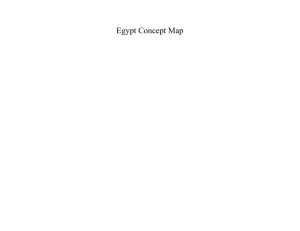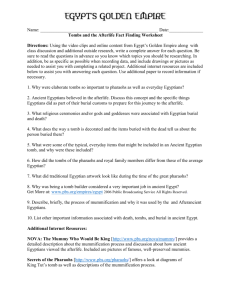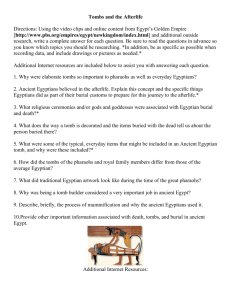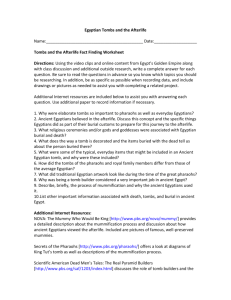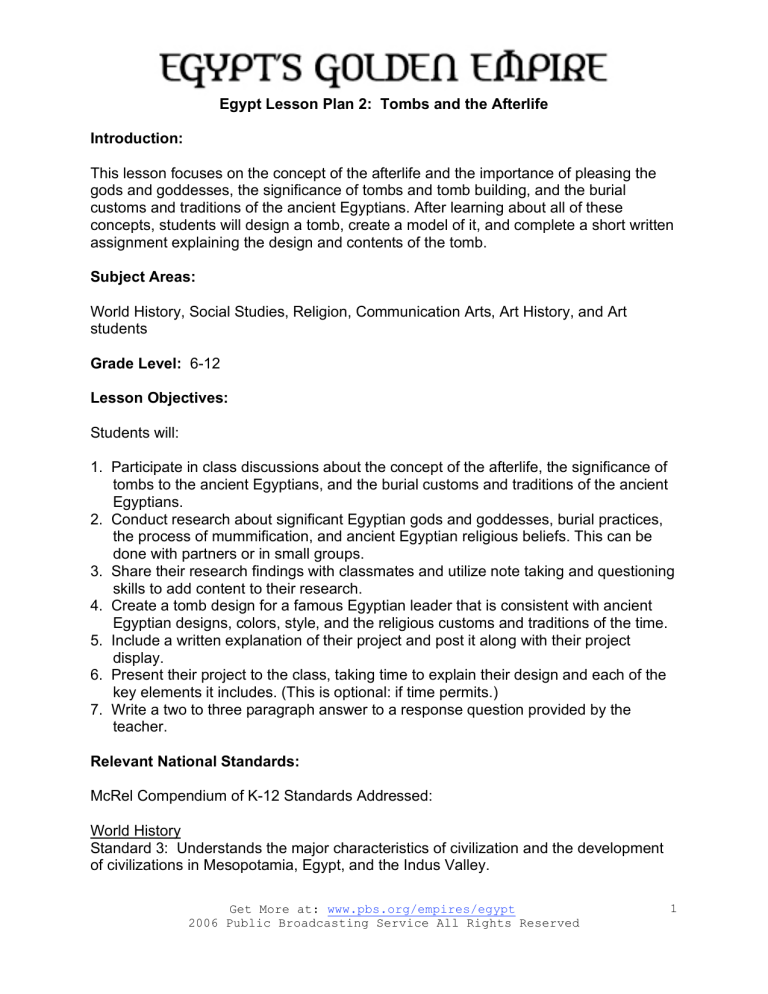
Egypt Lesson Plan 2: Tombs and the Afterlife Introduction: This lesson focuses on the concept of the afterlife and the importance of pleasing the gods and goddesses, the significance of tombs and tomb building, and the burial customs and traditions of the ancient Egyptians. After learning about all of these concepts, students will design a tomb, create a model of it, and complete a short written assignment explaining the design and contents of the tomb. Subject Areas: World History, Social Studies, Religion, Communication Arts, Art History, and Art students Grade Level: 6-12 Lesson Objectives: Students will: 1. Participate in class discussions about the concept of the afterlife, the significance of tombs to the ancient Egyptians, and the burial customs and traditions of the ancient Egyptians. 2. Conduct research about significant Egyptian gods and goddesses, burial practices, the process of mummification, and ancient Egyptian religious beliefs. This can be done with partners or in small groups. 3. Share their research findings with classmates and utilize note taking and questioning skills to add content to their research. 4. Create a tomb design for a famous Egyptian leader that is consistent with ancient Egyptian designs, colors, style, and the religious customs and traditions of the time. 5. Include a written explanation of their project and post it along with their project display. 6. Present their project to the class, taking time to explain their design and each of the key elements it includes. (This is optional: if time permits.) 7. Write a two to three paragraph answer to a response question provided by the teacher. Relevant National Standards: McRel Compendium of K-12 Standards Addressed: World History Standard 3: Understands the major characteristics of civilization and the development of civilizations in Mesopotamia, Egypt, and the Indus Valley. Get More at: www.pbs.org/empires/egypt 2006 Public Broadcasting Service All Rights Reserved 1 Historical Understanding Standard 2: Understands the historical perspective. Language Arts Writing Standard 3: Uses grammatical and mechanical conventions in written compositions. Standard 4: Gathers and uses information for research purposes. Reading Standard 5: Uses the general skills and strategies of the reading process. Standard 7: Uses reading skills and strategies to understand and interpret a variety of informational texts. Listening and Speaking Standard 8: Uses listening and speaking strategies for different purposes. Viewing Standard 9: Uses viewing skills and strategies to understand and interpret visual media. Art Standard 4: Understands the visual arts in relation to history and cultures. Working with Others Standard 4: Displays effective interpersonal communication skills Estimated Time: This should take two 90-minute class periods or four 50-minute class periods, plus additional time for classroom presentations and extension activities. Materials Needed: • • • • Video clips necessary to complete the lesson plan are available on the Egypt’s Golden Empire Web site [http://www.pbs.org/empires/egypt/index.html]. If you wish to purchase a copy of the program, visit the PBS Shop for Teachers [http://teacher.shop.pbs.org/product/index.jsp?productId=1406375]. Tombs and the Afterlife Fact Finding Worksheet [Download PDF here (64k)], part of this lesson plan. Tombs and the Afterlife Project Guide [Download PDF here (72k) ], part of this lesson plan. Assorted art supplies for creating projects. Get More at: www.pbs.org/empires/egypt 2006 Public Broadcasting Service All Rights Reserved 2 Procedures: 1. To perk student interest, write a phrase such as the following on the board/overhead: • “You can’t take it with you – or can you?” 2. Facilitate a very short class discussion about the quote using questions such as: • • When people say, “You can’t take it with you,” what do you think they mean? How does the meaning of the quote change when you add “– or can you?” 3. End the discussion by saying something like: “Today we’ll be learning about a group of people who believed that in order to pass successfully into the afterlife, you had to ‘take it with you.’” 4. Introduce students to ancient Egyptian tombs, burial practices, and the concept of the afterlife by viewing the clip Episode 3: Tombs and the Afterlife [insert pbs video link]. Take time to point out the importance of the tomb builders and their role in creating the hieroglyphic scenes that would help ensure the pharaoh’s safe trip to the afterlife. Using video clip Episode 2: King Tut’s Tomb [insert pbs video link], discuss the types of things that were placed in tombs to aid the dead on their way to the next life. Talk about the significance the Egyptians placed on taking worldly possessions with them after their death. 5. Explain to students that they will need to learn more about Egyptian gods and goddesses and burial practices, including mummification. They will also need to understand the artistry in tomb building. To assist them with this, distribute the Tombs and the Afterlife Fact Finding Worksheet [Download PDF here (64k)], part of this lesson plan. Take time to review each question in advance so students know what information they should be looking for throughout the remainder of the lesson. 6. Students will still need additional information to complete the Tombs and the Afterlife Fact Finding Worksheet [Download PDF here (64k)]. Using the Egypt’s Golden Empire Web site [http://www.pbs.org/empires/egypt/index.html], select: • • • • • • Religion [http://www.pbs.org/empires/egypt/newkingdom/religion.html] Priests [http://www.pbs.org/empires/egypt/newkingdom/priests.html] Workers [http://www.pbs.org/empires/egypt/newkingdom/workers.html] Architecture [http://www.pbs.org/empires/egypt/newkingdom/architecture.html] Virtual Egypt feature: Deir El Medina: Tomb of Sunnudjem [http://www.pbs.org/empires/egypt/special/virtual_egypt/deir.html] Virtual Egypt feature: Workers Tomb [http://www.pbs.org/empires/egypt/special/virtual_egypt/deir.html] Get More at: www.pbs.org/empires/egypt 2006 Public Broadcasting Service All Rights Reserved 3 There are also additional resources listed on the worksheet. Provide students with time to conduct research and answer each question. Encourage them to work in pairs or small groups while researching. 7. Discuss the answers to each question on the Tombs and the Afterlife Fact Finding Worksheet by having students share what they learned from conducting their research. As students share their findings, have them take additional notes to assist them with the completion of their projects. 8. Distribute the Tombs and the Afterlife Project Guide [Download PDF here (72k)], part of this lesson plan, to each student. Take time to review the project requirements as a group. Remind students to use their research findings to help them in the creation of their project. Provide them with at least one class period to work on their projects. Explain that the remainder of the work may need to be completed as a homework assignment. 9. When all projects have been completed, have students display their work around the classroom. Be sure that the required description is posted with each project. If time allows, offer each student two to three minutes to share their work and explain why they included various items or designs in their project. 10. As a closing activity, have students write a two to three paragraph response to one of the following questions: • If the practice of building elaborate tombs to lead people to the afterlife were still being used today, what types of objects, drawings, symbols, religious representations, and messages do you think might be included in an average tomb? Explain the significance of these items and why they might be included. Or • Based on what scientists have found in ancient Egyptian tombs, what are some of the most important historical or scientific discoveries you think have been made as a result of studying the contents and design of these tombs? Explain why you believe these discoveries are important. Assessment Suggestions: 1. Assign participation grades for class discussion activities. 2. Assign completion grades for work done on the Tombs and the Afterlife Fact Finding Worksheet. 3. Create a scoring guide to assess the quality of the Tombs and Afterlife Project Guide, including the description posted with the project. Get More at: www.pbs.org/empires/egypt 2006 Public Broadcasting Service All Rights Reserved 4 4. Assign a letter grade or percentage for the closing writing activity based on each student’s ability to answer the selected response question and support their answers using information learned from class and research activities. Extension Activities: 1. Research and discuss the practice of tomb raiding, including what caused people to desecrate tombs and mummies, what types of treasures were found, and the ethical issues faced by scientists who have uncovered tombs and removed their contents for further study. 2. Have students compare and contrast how other ancient cultures viewed death and whether or not they believed in an “afterlife” concept. Create T-charts, Venn Diagrams, or some other sort of graphic organizer to show the similarities and differences between the cultures. Related Resources: NOVA: The Mummy Who Would Be King [http://www.pbs.org/nova/mummy/] provides a detailed description about the mummification process and discussion about how ancient Egyptians viewed the afterlife. Included are pictures of famous, well-preserved mummies. Secrets of the Pharaohs [http://www.pbs.org/pharaohs/] offers a look at diagrams of King Tut’s tomb as well as descriptions of the mummification process. Scientific American Dead Men’s Tales: The Real Pyramid Builders [http://www.pbs.org/saf/1203/index.html] discusses the role of tomb builders and the fact that they were craftsmen and not slaves. A discussion of what was contained in the average worker’s tomb, as well as details about the tomb and how the body was buried are also included. Egyptian Afterlife, Coffins, and Mummy Masks [http://www.crystalinks.com/egyptafterlife.html] includes pictures, drawings, and explanations on the afterlife and the burial process used in ancient Egypt. The Ancient Egypt Web pages [http://members.aol.com/TeacherNet/AncientEgypt.html] supply links to a wide variety of subjects related to ancient Egypt. The Goddesses and Gods of Ancient Egypt [http://www.mnsu.edu/emuseum/prehistory/egypt/religion/godslist.html] provides a comprehensive list of the gods and goddesses along with an explanation of what they represented. There is also a pronunciation guide and a physical description of what the god/goddess looked like. Get More at: www.pbs.org/empires/egypt 2006 Public Broadcasting Service All Rights Reserved 5 The British Museum’s Gods and Goddesses [http://www.ancientegypt.co.uk/gods/explore/main.html] provides a comprehensive picture and alphabetical list of the most important gods and goddesses. There is also a physical description of what the god/goddess looked like and what they represented. Get More at: www.pbs.org/empires/egypt 2006 Public Broadcasting Service All Rights Reserved 6

